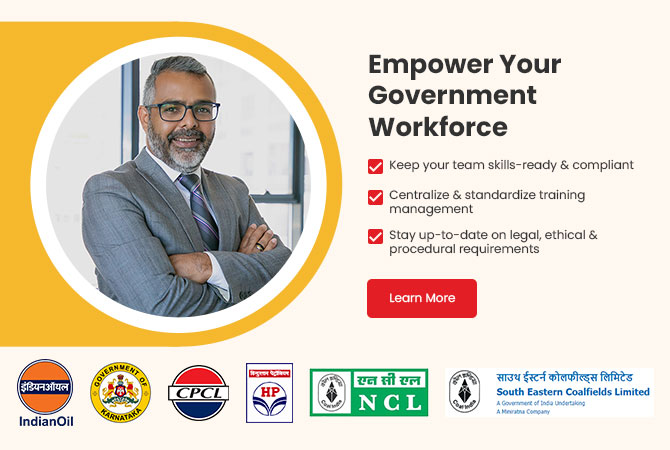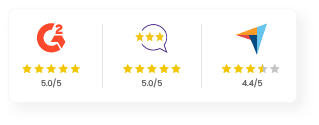12 Must-have Features in an LMS for Government
and Public Sector

While workforce Learning and Development (L&D) is crucial in all industries, it is especially necessary for government organizations and Public Sector Units (PSUs) for multiple reasons.
PSU companies operate in environments where policies and regulations frequently change. This means continuous learning is imperative to keep employees updated with the latest laws and compliance requirements.
Effective L&D programs are also essential for enhancing public service delivery by equipping government employees with the skills and knowledge that are needed to improve service quality and efficiency. Besides, L&D programs promote accountability by focusing on ethics and integrity — factors that are crucial for maintaining public trust.
Addressing skill gaps is another critical aspect as L&D programs help employees acquire new skills and adapt to evolving job requirements. This also better prepares them for crisis management as they are equipped with the knowledge to handle emergencies effectively.
Plus, as government organizations and PSUs increasingly adopt digital technologies, L&D programs are the key to support this digital transformation. Finally, L&D programs enhance collaboration and coordination within these organizations which leads to more integrated and effective service delivery.
Bottomline: L&D is especially necessary for government organizations and PSUs so that they can adapt more easily to constant regulatory changes and enhance their public service delivery. Implementing efficient training solutions is important, and an LMS can help by automating processes and enhancing the effectiveness and engagement of employee training.
Key Benefits of an LMS for the Public Sector
- LMS enables easy access to training, keeping employees updated with laws and regulations for effective performance.
- LMS standardizes ethics training which gives rise to a culture of integrity and transparency, in turn, preventing corruption.
- LMS caters to diverse and dispersed public sector workforces, including blue collar and knowledge workers as well as the extended enterprise, offering centralized training across various roles and locations.
- LMS offers the flexibility to scale to meet the growing needs of the PSU.
- LMS increases employee engagement and retention with personalized learning paths, content recommendations, gamification, collaboration etc.
- Cloud-based LMS reduces training costs by eliminating physical infrastructure needs and streamlining administrative processes.
- LMS can be tailored to fit professional development and training requirements of the PSU.
12 Essential Features to Look for in an LMS for Government
Here’s a list of some must-have features in your LMS if you are a government organization:
1. Security
Security is crucial when choosing an LMS for government because it ensures the protection of sensitive data, including personal information and confidential government records, from unauthorized access and cyber threats.
Seek out an LMS provider that offers zero-trust security, controlled cloud access and data breach prevention, robust data encryption measures, all while regularly conducting rigorous security testing practices.
2. Compliance Training
Compliance forms a very crucial aspect of any government learning and development initiative. It is imperative to have an LMS that facilitates the delivery of compliance training to ensure that all employees receive consistent, up-to-date training on regulations and standards, reducing the risk of non-compliance and potential legal issues.
Your LMS should enable tracking and documenting training progress, to demonstrate compliance during audits and inspections. Additionally, it should also provide a clear overview of employees’ compliance status so that managers can quickly identify who is up to date with training requirements. Moreover, it should automatically notify managers and enroll employees for compliance training renewal when necessary.
3. Assessments & Certifications
Assessments and certifications are key features to prioritize in a government LMS as they provide measurable proof of competency and compliance with regulatory requirements. Additionally, certifications motivate employees to pursue continuous learning and professional development, enhancing overall efficiency and accountability within government operations.
Look for versatile assessment tools for quizzes and tests, automated grading and robust certification management capabilities. Integration with third-party certification bodies improves regulatory standards adherence and efficient learning outcome assessment.
4. Scalability and Integrations
Given the large workforce of government agencies, it is crucial to select an LMS that can scale effectively to meet demand. Your chosen LMS should accommodate a high volume of concurrent logins, and remain adaptable to evolving needs and requirements.
Integrations also play a key role here. Ensure that the LMS seamlessly integrates with your existing workplace software and systems like Human Resource Management System (HRMS), Enterprise Resource Planning (ERP), Content Management System (CMS), and video conferencing tools, so that learners get a smooth and well-integrated learning experience through single sign-on (SSO) capabilities.
5. Personalized Learning & Role based Access
Government organizations typically comprise several departments, each tasked with distinct responsibilities. These departments may even have sub-departments, further segmenting duties. Your LMS must accommodate personalized online training paths to enhance workplace efficacy.
See that your LMS offers access to your learners to training materials that is relevant to their roles and responsibilities. It should guide them through a series of courses and activities that are specifically tailored to their roles, skills, or learning objectives.
6. Multi-Tenancy Setup for Extended Enterprise Training
Central as well as state government agencies include vast communities of users across various programs, components and agencies. A multi-tenant LMS setup enables you to cater to these extended enterprise audiences, along with your employees, within a single LMS instance.
In this setup, each client organization, or tenant, has its data and configuration virtually partitioned. Each tenant can customize its branding, courses, certifications, roles and dashboards independently. Multi-tenancy ensures a consistent user experience and simplifies LMS management. You can centrally administer and update the software globally via the main site, eliminating the need for duplicative processes.
7. Mobile Support
Often, government employees, especially those in blue-collar roles or those constantly on the move for site visits, interdepartmental tasks or public engagements, may not have access to their machines. This makes mobile learning imperative so that training and development opportunities are accessible anytime, anywhere, supporting this dynamic nature of their work on the go.
Employees can download training materials, complete activities, and then sync with the LMS when back online with offline learning capability.
8. ILT & VILT
For complex topics that require instructor-led training sessions, whether conducted in person or virtually, choosing an LMS with robust Instructor-led Training (ILT) and Virtual ILT features is crucial.
ILT and VILT enable easy QR code-based attendance tracking, streamlined nomination workflows, efficient venue management for in-person classroom sessions and easy integration with video conferencing tools. With these modules, training programs are well-organized and engaging with more effective learning outcomes.
9. Multi Language Support
In the public sector, employees are often dispersed across geographies, each with its own unique cultural and linguistic nuances. Therefore, ensuring training accessibility across all departments is crucial.
Choosing an LMS that offers robust multi-language support enables easy platform adoption for employees with different language preferences. By offering localized platform UI along with training materials in multiple languages, you can ensure that every employee, regardless of their linguistic background, can fully participate and benefit from the training initiatives.
10. User-friendly UI/UX
For a government LMS, user-friendly UI/UX is paramount. The system needs to have an intuitive interface tailored to accommodate a diverse workforce which spans blue-collar and white-collar employees, as well as individuals of varying tech expertise and generational backgrounds.
Such design facilitates seamless navigation and accessibility which promotes engagement and more effective learning experiences across all user demographics.
11. Reporting & Analytics
A government LMS needs to have comprehensive reporting and analytics with intuitive dashboards, making training metrics and learner performance easy to understand. This functionality helps administrators make informed, data-driven decisions to enhance training effectiveness and learner outcomes.
12. Competency Management
Competency management is crucial in an LMS for government so that there is structured skill assessment across job roles. It categorizes competencies (e.g., Finance, Management) with defined proficiency levels, aligning training with organizational goals.
This helps support assessments ensuring compliance and continuous improvement. Robust reporting provides insights into competency progress, further enabling informed decision-making and enhancing workforce effectiveness.
How Enthral LMS Helps Public Sector
Enthral’s feature-rich LMS meets the unique needs of government and public sector organizations. With its outstanding scalability and security features, and support for multi-tenancy LMS setup, Enthral offers everything required to manage successful training programs effectively.
Learners can access engaging and personalized learning pathways from any device, while L&D leaders can effortlessly track compliance, automate enrollments and ensure a consistent learning experience.
Whether your goals involve onboarding new employees, keeping everyone informed about the latest regulations, or fostering employee engagement through career development, Enthral is your ally in achieving these objectives.












